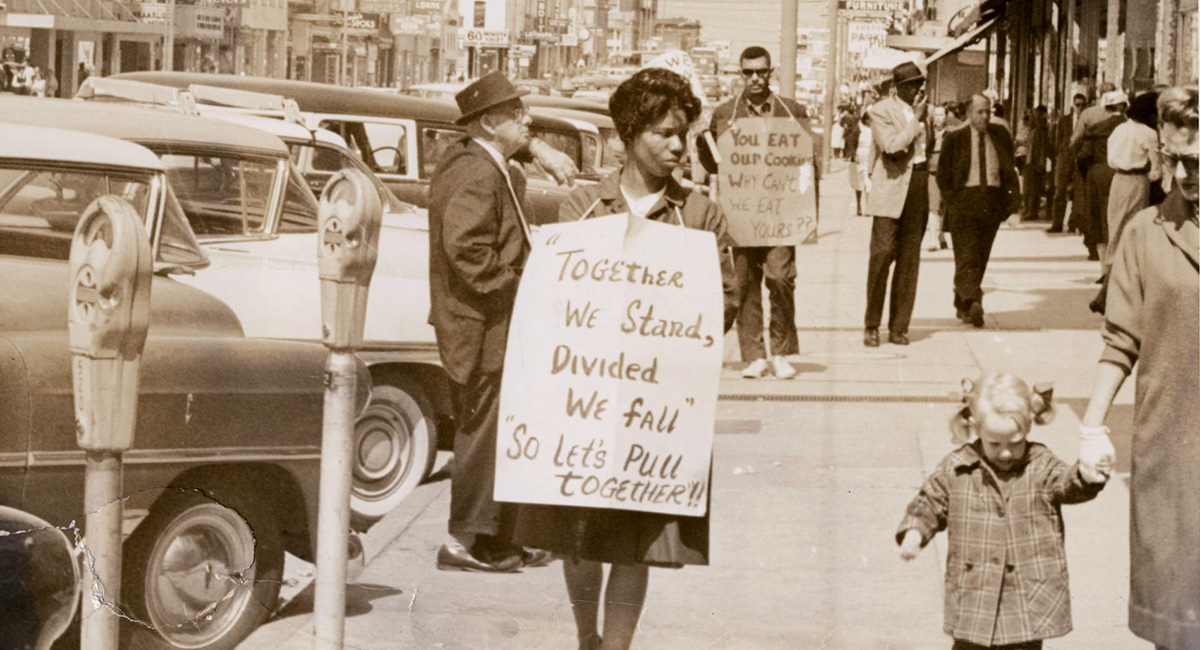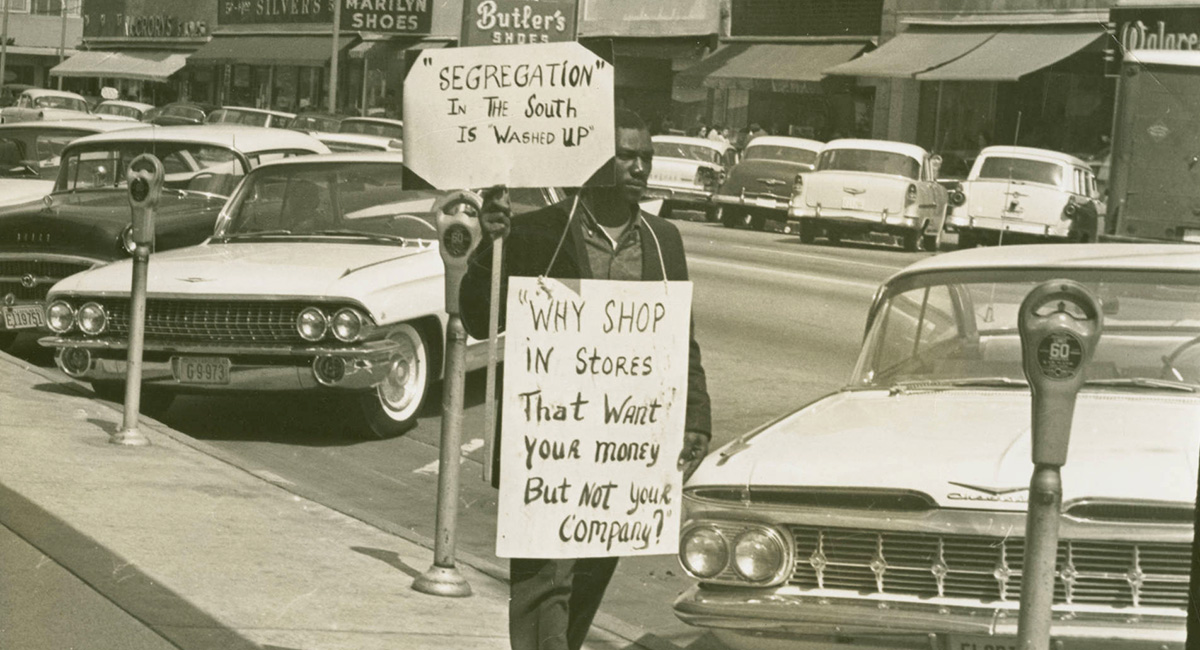Justice for All
UofSC deepens understanding of South Carolina’s role in national civil rights movement
Posted on: June 13, 2019; Updated on: June 13, 2019
By Carol J.G. Ward, ward8@mailbox.sc.edu, 803-777-7549
Let us march on ballot boxes until we are able to send to the statehouses of the South men who will do justly, love mercy and walk humbly with their God. Let us march on ballot boxes. — Martin Luther King Jr.
These words in the distinctive and powerful voice of Martin Luther King Jr. greet visitors as they enter Justice for All: South Carolina and the American Civil Rights Movement, an exhibit in the Ernest F. Hollings Special Collections Library. They’re from a speech that King gave in Kingstree, South Carolina, on Mother’s Day 1966.
King was in the state a year after the Voting Rights Act became law. He recognized the legislation was a means to an end and that he had to encourage African Americans to vote and seek elective office for changes to be made.
“Dr. King and his associates thought that if ever there was a place that could lead to the election of African Americans, it might be in those rural black-majority counties like Williamsburg. So, he accepted an invitation to come,” says Bobby Donaldson, professor of history and director of the Center for Civil Rights History and Research.

Bobby Donaldson, history professor and director of the UofSC Center for Civil Rights History and Research, and graduate assistant Jill Found searched through thousands of items in University Libraries’ special collections to select the oral history recordings, film clips, photographs, letters and news clippings displayed in the Justice for All exhibit.
The clip of King's "March on the Ballot Boxes" speech from the University Libraries’ Moving Images Research Collection is an example of what visitors experience throughout the exhibit: Something or someone familiar or well-known in the civil rights movement juxtaposed against a less familiar event or person — often with a South Carolina connection to share the impact of the state’s role in the national movement.
“It was a movement of many parts and many individuals, and you see and hear that throughout this exhibit — ordinary people who may never have been written down in a textbook but who were key and integral to moving it forward,” Donaldson says.
The exhibit, open through Aug. 2, uses hundreds of oral history recordings, film clips, photographs, letters and news clippings from University Libraries’ special collections to highlight largely overlooked chapters in the efforts to advance justice and equality. It also includes items that illustrate opposition in South Carolina and elsewhere to the civil rights movement and its challenge to tradition and power.
“We knew some of the materials we wanted to include — key pieces we had that were
definitely going to be in here. And then we had materials that we hadn’t really explored,”
says Jill Found, a graduate assistant who helped organize the displays. “Some of our
first steps were looking through some of these really big collections and finding
exciting things we could include … It was an opportunity to put materials together
from different collections that speak to the same event.”

S.C. is pivotal in national movement
As visitors move through the exhibit, themes such as education, voting and economic rights emerge, showing South Carolina’s role in broader national events such as the end of segregation in transportation and education.
Among the highlighted events is a bus desegregation case filed by South Carolinian Sarah Mae Flemming. For many years, Flemming, an Eastover native, was an unsung hero in the civil rights movement. In 1954, a driver in Columbia expelled her from the bus after accusing her of sitting in the whites-only section. Seventeen months before Rosa Parks refused to leave her seat on a bus in Montgomery, Alabama, 20-year-old Flemming sued SCE&G, which operated the buses in Columbia. Her little-publicized case in South Carolina played an important role in the later success of Parks’ bus protest in Alabama.
Donaldson illustrates for students South Carolina’s role in the pursuit of social justice in his courses on the civil rights movement. “Students are amazed that there was somebody before Rosa Parks — and that somebody was from South Carolina,” he says.
There’s also the 1950 Briggs v. Elliott case that challenged school segregation in Clarendon County, South Carolina. The case was named for Harry Briggs, one of 20 parents who brought suit with the help of Thurgood Marshall, lead counsel for the NAACP Legal Defense Fund, and Harold Boulware, a Columbia lawyer. It was the first of five cases that became part of the 1954 Brown v. Board of Education ruling that declared segregation of schools unconstitutional.
“This exhibit highlights that in nearly every corner of the state, there were civil rights events and activities which most people don’t think about,” Donaldson says. “I mean Kingstree. Why would Dr. King be in Williamsburg County in 1966? Or why would Summerton in Clarendon County be a key place for challenging inequities in education.”
In the years leading up to MLK’s death, the movement focused on poverty, jobs, and economic rights, and in 1969 — a year after his assassination — the Charleston Hospital Workers Strike put South Carolina in the national spotlight. Four hundred black hospital workers, unhappy about unfair treatment and unequal pay, went on strike at two Charleston hospitals. The strike, which began in March and lasted 113 days, gained national attention when the Southern Christian Leadership Conference stepped in. MLK’s chief lieutenants, including Andrew Young and Ralph Abernathy, and widow, Coretta Scott King, came to Charleston in support of the workers. On Mother’s Day 1969, 5,000 people marched on the city in protest. The strike had national impact, inspiring hospital workers and others across the country.
Justice for All displays planning documents for the strike; photographs; video footage of demonstrations, marches and Coretta Scott King’s speech in Charleston; and responses of leading S.C. politicians such as Gov. Robert McNair.
“The hospital strike is a reminder that people continued to protest and organize even
after Dr. King’s passing, and many viewed the struggle as the continuation of his
work,” Donaldson says. “It also shows that movement was focused not simply on voting
rights and civil rights but also on economic justice, and the strike magnified that
in powerful ways.”
Bringing history to life
Donaldson credits his predecessors at the university for the wealth of material that is available for the Justice for All exhibit. He and Found worked with University Libraries and archivists in multiple collections.
“We had themes and certain ideas, and we started digging to populate those cases. This is just a scratch of the surface of what we discovered,” Found says.
Justice for All fills all the exhibit space in the Thomas Cooper and Ernest F. Hollings Special Collections libraries — something that has not been done before. It is also on display for six months — instead of the typical one to two months — to increase the opportunity for the public to experience and understand the cultural and social impact of the civil rights movement in South Carolina and beyond.
School groups, university classes and even family reunions have toured the exhibit. On a recent Monday, a school group was treated to an impromptu visit with Sarah Collins Rudolph, a survivor of the 1963 Birmingham church bombing, who was at the library prior to a speaking engagement sponsored by the Center for Civil Rights History and Research.
“Many people think of history as a terribly boring topic, but this exhibit helps us bring this history to life by illuminating, visualizing and vocalizing the past,” Donaldson says. “I think when students can view a petition or photograph, watch a demonstration or listen to an oral interview, some of this historical information makes more sense.”
Donaldson shares the story of a family, originally from Bamberg, who organized a family reunion with a visit to the exhibit in February to hear guest speaker Cecil Williams, a civil rights photographer. The family members are descendants of Isaac Nimmons, who had been a servant of William Gilmore Simms, an S.C. writer, editor and politician. The family had salvaged some historical photographs, which they decided to archive at UofSC.
“Family members came from all over the country. And there was this child, about 6
years old, and he clearly took an interest in the exhibit because at the end of the
reception, his mother showed me a notebook that he had kept during those two hours
he was here. He became symbolic for us because if a 6-year-old can grab hold of some
of this information, we hope others will as well,” Donaldson says.

Having an impact on the future
Among Donaldson’s favorite items in the exhibit is video footage from 1961 of students who traveled to South Carolina in support of the Friendship Nine, a group of young men who were arrested for participating in a lunch counter sit-in in Rock Hill, South Carolina. In the footage, the camera pans down a line of protesters. Donaldson shared his excitement as he spotted a figure who looked familiar: “I said, ‘Do you all know who that is? That is Congressman John Lewis who was in Rock Hill in February of 1961.”
In Lewis’ three-part graphic memoir, The March, he writes that his first time in South Carolina was May 1961 when he participated in the Freedom Rides, which challenged segregation on interstate buses and bus terminals. When Lewis received an honorary degree from the university two years ago, Donaldson mentioned that he had come to the state before and showed him the February 1961 footage from Rock Hill, a trip Lewis had forgotten.
Donaldson says losing those memories make him anxious. With many of the milestone events of civil rights movement happening five to six decades ago, most of the adult leaders are deceased, and student leaders are now in their mid-70s and early 80s. During the course of the Justice for All exhibit, Donaldson and others have reached out to participants in the civil rights movement to gather oral histories, identify photographs, provide context and spark memories with items from the collections.
“That’s exciting because many of these items are being removed from boxes and displayed for the first time. And we now have an opportunity to provide additional context to the historical record for students and scholars,” Donaldson says.
Going to the exhibit
Justice for All: South Carolina and the American Civil Rights Movement is free and open to the public through Aug. 2 in the Ernest F. Hollings Special Collections Library. The public is invited to a reception and program 6-8 p.m. Thursday, June 20, to honor the young activists of the Civil Rights Movement, including Sarah Mae Flemming. To arrange a group or school tour, contact Michael Weisenburg, 803-777-2721 or weisenbu@mailbox.sc.edu. The exhibit is the work of the Center for Civil Rights History and Research in partnership with the University of South Carolina Libraries and the College of Arts and Sciences, with grant funding from South Carolina Humanities.